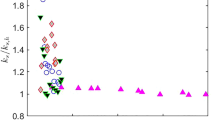Abstract
The roughness sublayer in a turbulent open-channel flow over a very rough wall is investigated experimentally both within the canopy and above using particle image velocimetry by gaining complete optical access with new methodologies without disturbing the flow. This enabled reliable estimates of the double-averaged mean and turbulence profiles to be obtained by minimizing and quantifying the usual errors introduced by limited temporal and spatial sampling. It is shown, for example, that poor spatial sampling can lead to erroneous vertical profiles in the roughness sublayer. Then, in order to better define and determine the roughness sublayer height, a methodology based on the measured spatial dispersion is proposed which takes into account temporal sampling errors. The results reveal values well below the usual more ad hoc estimates for all statistics. Finally, the double-averaged mean and turbulence statistics in the roughness sublayer are discussed.












Similar content being viewed by others
References
Amir M, Castro IP (2011) Turbulence in rough-wall boundary layer. Universality issues. Exp Fluids 51:313–326
Antonia RA, Djenidi L (2010) On the outer layer controversy for a turbulent boundary layer over a rough wall. In: IUTAM symposium on the physics of wall-bounded turbulent flows on rough walls, vol 22. IUTAM Bookseries, pp 77–86
Bendat JS, Piersol AG (1971) Random data: analysis and measurement procedures, 2nd edn. Wiley, New York
Birch DM, Morrison JF (2011) Similarity of the streamwise velocity component in very-rough-wall channel flow. J Fluid Mech 668:174–201
Bottema M (1996) Roughness parameters over regular rough surfaces: experimental requirements and model validation. J Wind Eng Ind Aero 64:249–265
Bradshaw P (2000) A note on “critical roughness height” and “transitional roughness”. Phys Fluids 12:1611–1614
Britter RE, Hanna SR (2003) Flow and dispersion in urban areas. Annu Rev Fluid Mech 35:469–496
Castro IP (2007) Rough-wall boundary layers: mean flow universality. J Fluid Mech 585:469–485
Castro IP, Cheng H, Reynolds R (2006) Turbulence over urban-type roughness: deductions from wind-tunnel measurements. Bound Layer Meteorol 118:109–131
Cheng H, Castro IP (2002) Near wall flow over urban-like roughness. Bound Layer Meteorol 104:229–259
Christensen KT (2004) The influence of peak-locking errors on turbulence statistics computed from piv ensembles. Exp Fluids 36:484–497
Coceal O, Belcher SE (2004) A canopy model of mean winds through urban areas. Q J R Meteorol Soc 130:1349–1372
Coceal O, Thomas TG, Castro IP, Belcher SE (2006) Mean flow and turbulence statistics over groups of urban-like cubical obstacles. Bound Layer Meteorol 121:491–519
Fincham A, Delerce G (2000) Advanced optimization of correlation imaging velocimetry algorithms. Exp Fluids 29:S13–S22
Fincham A, Spedding GR (1997) Low cost, high resolution dpiv for measurements of turbulent fluid flow. Exp Fluids 23:449–462
Finnigan J (2000) Turbulence in plant canopies. Annu Rev Fluid Mech 32:519–571
Flack KA, Schultz MP, Shapiro TA (2005) Experimental support for townsend’s reynolds number similarity hypothesis on rough walls. Phys Fluids 17(3):035102.1–035102.9
Florens E (2010) Couche limite turbulente dans les écoulements à surface libre: étude expérimentale d’effets de macro-rugosités. PhD thesis, Université de Toulouse, France
Flores O, Jiménez J (2006) Effect of wall-bounded disturbances on turbulent channel flows. J Fluid Mech 566:357–376
Hong J, Katz J, Schultz MP (2011) Near-wall turbulence statistics and flow structures over three-dimensional roughness in a turbulent channel flow. J Fluid Mech 667:1–37
Jiménez J (2004) Turbulent flows over rough walls. Annu Rev Fluid Mech 36:173–196
Macdonald RW (2000) Modelling the mean velocity profile in the urban canopy layer. Bound Layer Meteorol 97:25–45
Manes C, Pokrajac D, McEwan I (2007) Double-averaged open-channel flows with small relative submergence. J Hydr Eng 133(8):896–904
Mignot E, Barthelemy E, Hurther D (2009) Double-averaging analysis and local flow characterization of near-bed turbulence in gravel-bed channel flows. J Fluid Mech 618:279–303
Nepf H, Vivoni ER (2000) Flow structure in depth-limited, vegetated flow. J Geophys Res 105:28547–28557
Nezu I, Nakagawa H (1993) Turbulence in open-channel flows. IAHR Monograph series. A.A. Balkema, Rotterdam
Nezu I, Rodi W (1985) Experimental study on secondary currents in open channel flow. In: Proceedings of 21st congress of IAHR, Melbourne, vol 2, pp 115–119
Nikora V, McEwan I, McLean S, Coleman S, Pokrajak D, Walters R (2007) Double-averaging concept for rough-bed open-channel and overland flows: theoretical background. J Hydr Eng 133(8):873–883
Nikora VI, Goring DG, McEwan I, Griffiths G (2001) Spatially averaged open-channel flow over rough bed. J Hydr Eng 126(2):123–133
Poggi D, Katul GG, Albertson JD (2004a) A note on the contribution of dispersive fluxes to momentum transfer within canopies. Bound Layer Meteorol 111:615–621
Poggi D, Porporato A, Ridolfi L, Albertson JD, Katul GG (2004b) The effect of vegetation density on canopy sub-layer turbulence. Bound Layer Meteorol 111:565–587
Pokrajac D, Campbell LJ, Nikora VI, Manes C, McEwan IK (2007) Quadrant analysis of persistent spatial velocity perturbations over square-bar roughness. Exp Fluids 42:413–423
Raupach MR, Shaw RH (1982) Averaging procedures for flow within vegetation canopies. Bound Layer Meteorol 61(1):47–64
Raupach MR, Thom AS, Edwards I (1980) A wind-tunnel study of turbulent flow close to regularly arrayed rough surfaces. Bound Layer Meteorol 18:373–397
Raupach MR, Antonia RA, Rajagopalan S (1991) Rough-wall turbulent boundary layers. Appl Mech Rev 44(1):1–25
Reynolds RT, Castro IP (2008) Measurements in a urban-type boundary layer. Exp Fluids 45:141–156
Rotach MW (1999) On the influence of the urban roughness sublayer on turbulence and dispersion. Atmos Environ 29:4001–4008
Rotach MW (2001) Simulation of urban-scale dispersion using a lagrangian stochastic dispersion model. Bound Layer Meteorol 99:379–410
Tomas S, Eiff OS, Masson V (2011) Experimental investigation of turbulent momentum transfer in a neutral boundary layer over a rough surface. Bound Layer Meteorol 138(3):385–411
Acknowledgments
This work was partially supported by Hydralab IV project funded by the European Commission (Grant Number 261520). Help in conceiving and setting up the optical experiments is gratefully acknowledged to S. Cazin and E. Cid.
Author information
Authors and Affiliations
Corresponding author
Rights and permissions
About this article
Cite this article
Florens, E., Eiff, O. & Moulin, F. Defining the roughness sublayer and its turbulence statistics. Exp Fluids 54, 1500 (2013). https://doi.org/10.1007/s00348-013-1500-z
Received:
Revised:
Accepted:
Published:
DOI: https://doi.org/10.1007/s00348-013-1500-z




